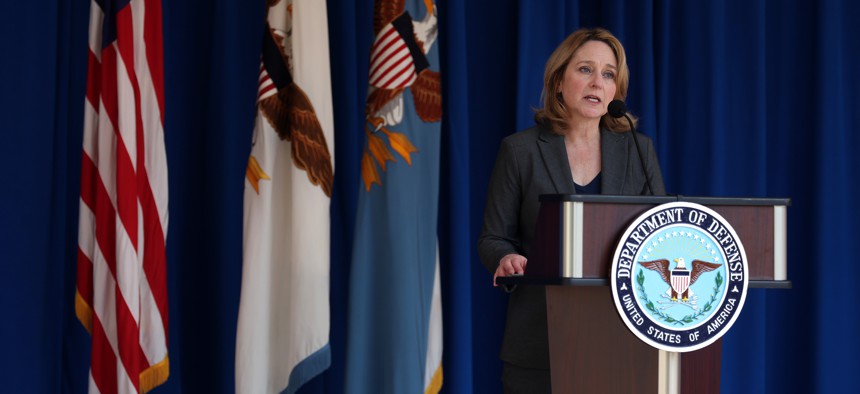
Deputy Secretary of Defense Kathleen Hicks, seen here speaking at a September 11th memorial at the Pentagon, called the development of CJADC2 'no easy task.' Alex Wong/Getty Images
The Pentagon's connect-everything effort has a minimum viable product
An initial version of CJADC2 is “low latency and extremely reliable,” Deputy Defense Secretary Hicks said.
An initial version of the Pentagon's effort to digitally link the vast majority of its IT systems is up and running, the Pentagon's No. 2 leader said Wednesday.
“The minimum viable capability for CJADC2 is real and ready now,” calling it “low latency and extremely reliable,” Deputy Defense Secretary Kathleen Hicks said at a defense data and AI symposium hosted by the Pentagon's Chief Digital and Artificial Intelligence Office, or CDAO.
CJADC2—short for combined joint all-domain command and control—aims to improve communication across disparate military environments, including those in air, land, sea and cyberspace.
Hicks said she “challenged” CDAO last summer to produce a basic version of CJADC2 by the end of 2023, but she was vague about DOD’s immediate use or need for the initial capability.
“For security reasons, I can't say where or what that capability is for, but I can tell you it was no easy task, especially in six months,” Hicks said.
DOD’s March 2022 implementation plan for the initiative — initially dubbed JADC2 — called it “a warfighting necessity” that would allow military commanders “to ‘sense,’ ‘make sense’ and ‘act’ on information across the battle-space quickly using automation, artificial intelligence, predictive analytics and machine learning to deliver informed solutions via a resilient and robust network environment.”
Hicks cited the initial deployment of CJADC2 to show that DOD’s investments in data and AI capabilities are empowering the department “to be ahead of the curve, not chasing the curve” when it comes to adopting and fielding emerging technologies. But she drew a distinction between the Pentagon’s embrace of AI and other novel tools and concerns about broader militarized uses of innovative systems moving forward.
“These efforts are advancing U.S. capability in material ways, but they are not signs of an AI arms race,” she said. “That's not how we see it, nor do we seek such an arms race. After all, data and AI are not weapons; they're fundamental, general purpose technologies, like electricity.”
Beyond enhancing communication between military personnel operating across different military domains, the initial CJADC2 capability also serves as an effective use case for how DOD can use quality data to drive its embrace of AI and other capabilities.
During a keynote address at the symposium on Tuesday, Chief Digital and Artificial Intelligence Officer Craig Martell said full-scale deployment of CJADC2 will rely on proper use of high-quality data that is “discoverable, accessible and available” across all warfighting domains.
Martell expanded on those comments during a media roundtable on Thursday, calling CJADC2 one of DOD’s “marquee use cases” when it comes to effectively identifying and using high-quality data across the department to “bring immediate value.”
“We metaphorically say we're looking for 10% to 13% of the data that's getting 60% of the value,” Martell said about the Pentagon’s wealth of collected intelligence, adding that CDAO is leveraging the most effective information to “drive those use cases, and we make that data quality.”


